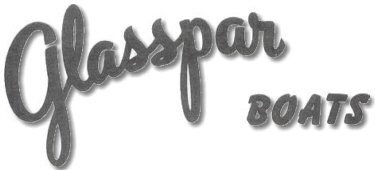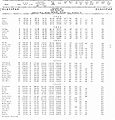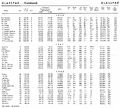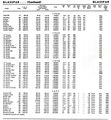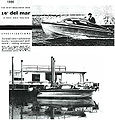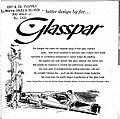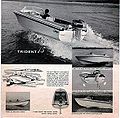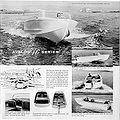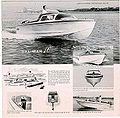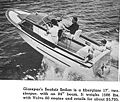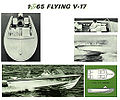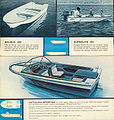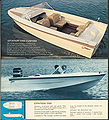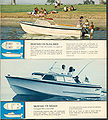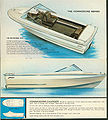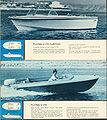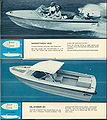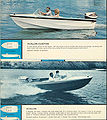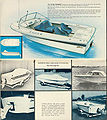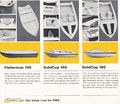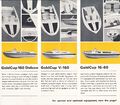Difference between revisions of "Glasspar"
(added 1958 article) |
(added 1958 article) |
||
| Line 89: | Line 89: | ||
File:Glassparb58006.jpg | 1958 Brochure, p6 | File:Glassparb58006.jpg | 1958 Brochure, p6 | ||
File:Glassparb58007.jpg | 1958 Brochure, p7 | File:Glassparb58007.jpg | 1958 Brochure, p7 | ||
| − | File:Glasspara58001.jpg|1958 Article | + | File:Glasspara58001.jpg|1958 Glasspar New Models Article |
| + | File:Glasspara58002.jpg|1958 Glasspar New Models Article | ||
</gallery> | </gallery> | ||
Revision as of 21:43, 10 October 2015
History Needed, please contact us if you'd like to edit this page or have something to contribute.
Glasspar Company
19101 Newport Ave.
Santa Ana, California
Other locations: Nashville, Tennessee; Olympia, Washington; Colonial Heights/Petersburg, Virginia
History by Matthew Tritt, son of Bill Tritt
Glasspar was founded in about 1948 by my father, Bill Tritt, in Costa Mesa, Ca, for the purpose of building fiberglass masts (spars) and small boats. The earliest of the boats was the Green Dolphin, named for the man who financed the 21' sailboat's development, John Green of Santa Barbara. After the Green Dolphin came a series of small sail and power boats including the Dincat (12' sailing dinghy/tender), the Dinkitten (8' sailing dinghy/tender), the Sea Lion and Car-Topper open skiffs and then a 21' cabin cruiser who's name I don't remember. Dad then designed and built the G2 sports roadster in '51, first called the Brooks Boxer (built for Major Ken Brooks of Lido Island in Newport Harbor, Ca), and then changed to G2. The G2 is a well known and studied automobile (see the website Forgotten Fiberglass) and it's development entailed the building of a fiberglass removable hardtop, which then led to building tops for Porsche, MG and others. These tops were so well made that many people today believe that they were supplied by Porsche, which they were not. Glasspar was incorporated in '51 and Dad designed all of their products (including aircraft components for Douglas Aircraft and wing drop boats for Paul Mantz) up until 1960, when he lost the company through corporate hi-jinx. During it's heyday in the mid-50's, Glasspar was the largest and most influential supplier of fiberglass boats in the country. You read more by visiting Wikipedia under Glasspar and/or Bill Tritt.
History from a variety of sources
The Glasspar Company was incorporated in December 1950 to develop fiberglass products and its first offerings were fiberglass tops and bodies for sports cars (the Glasspar G2), cabs for construction equipment, and outboard boats. In 1954, Glasspar had 27,000 sq ft of production space in the Santa Ana location; by 1958 they expanded to three more locations for a total of 146,000 sq. ft. (Barron's National Business and Financial Weekly, Aug 11, 1958).
For the fiscal year ending Nov. 30, 1958, Glasspar had $6,514,420 in sales and profit of $464,910. At the 1959 annual shareholder meeting in February, L.J. Neiger, company president announced the success of the new G3 model and the addition of 200 new dealers in the past three months, bringing the total to 1400 dealers (Los Angeles Times, March 1, 1959).
Otto E. Bayer retired from the Glasspar Board of Directors in 1959. He was listed as "a founder, director, and officer of the compay" (Los Angeles Times, Sept. 20, 1959). Bill Tritt, co-founder, had left the company prior to Bayer's resignation.
Glasspar announced it would open its sixth plant in October 1961 at Sturgis, Michigan, to join the Santa Ana CA, Nashville TN, Olympia WA, Petersburg VA, and Sherman TX facilities (Los Angeles Times, Sept. 19, 1961).
The leased 10,000 sq ft. Sherman, Texas plant, opened in 1960, was closed August 1, 1962. L.J. Neiger was company president at the time (Wall Street Journal, July 12, 1962).
Glasspar was finally liquidated in 1966 when assets were sold to Larson Industries of St. Paul, Minnesota for 116,430 shares of stock. Glasspar had only one profitable year since 1960. Glasspar lost $459,860 on total sales of $4,518,015 for the first half of 1966 and lost $484,841 on 1965 sales of $6,075,506. Liabilities due as of June 30, 1966 totaled $2,190,000. At the time of the liquidation, Glasspar still had the Nashville, Santa Ana, and Colonial Heights plants and peak seasonal employment of 500. At the time, Larson Industries, with Earl Geiger as president, had operations in St. Paul and Little Falls, Minnesota, as well as Laconia, New Hampshire (Los Angeles Times, Oct. 9 and Oct. 23 1966).
Model Information
1955 Information:
1956 Information:
1956 Glasspar Runabout Mercury Mark 25 test
1956 Glasspar Del Mar Mercury Mark 55 test
1957 Information:
1958 Information:
1959 Information:
1960 Information:
1961 Information:
1963 Information:
1964 Information:
1965 Information:
1966 Information:
1968 Information:
1969 Information:
1969 Glasspar Cutlass 18' Mercury 1250EL test
Misc:
